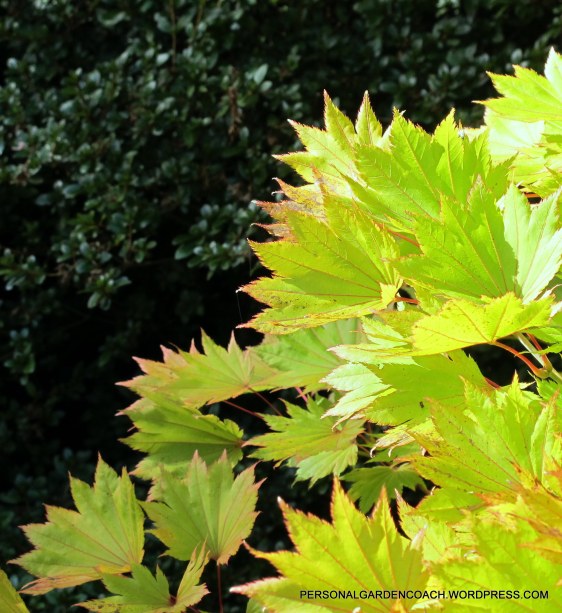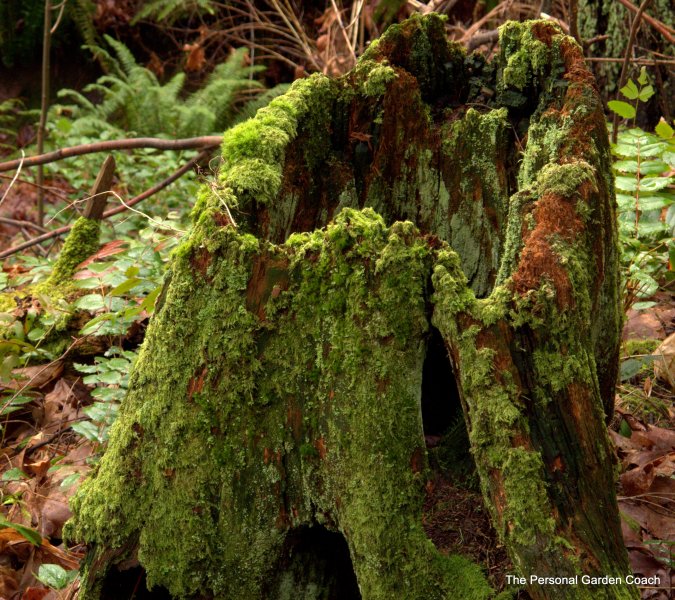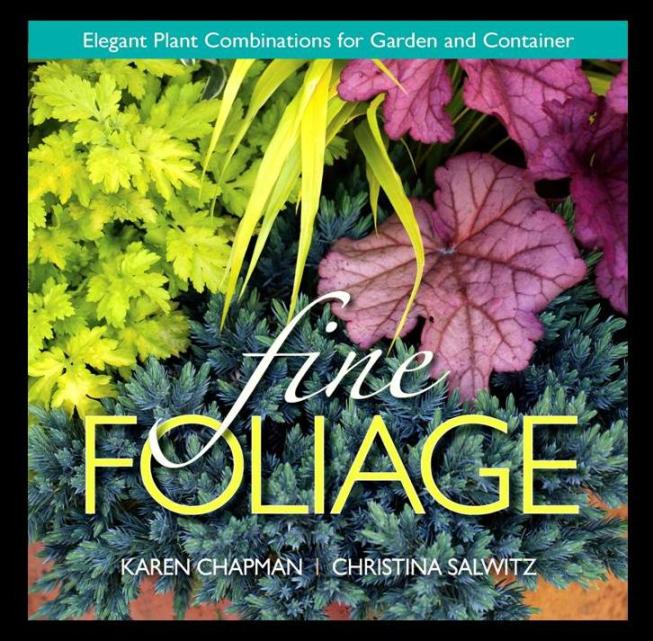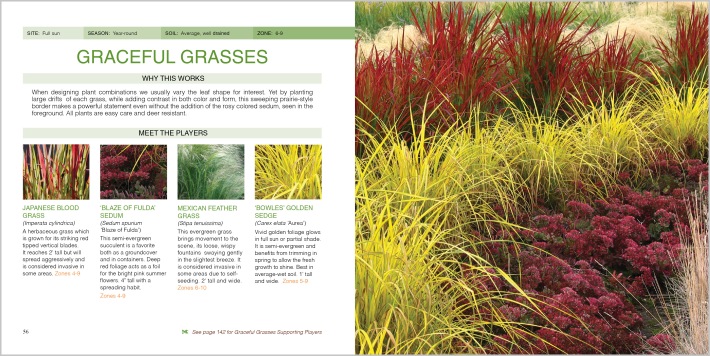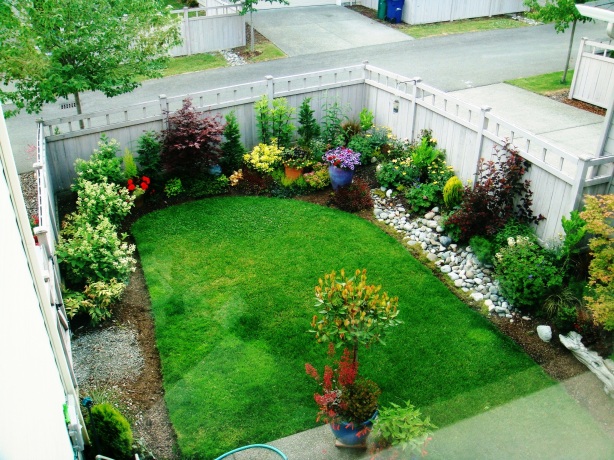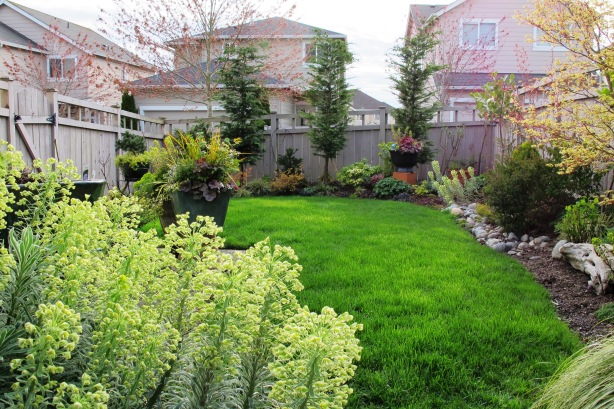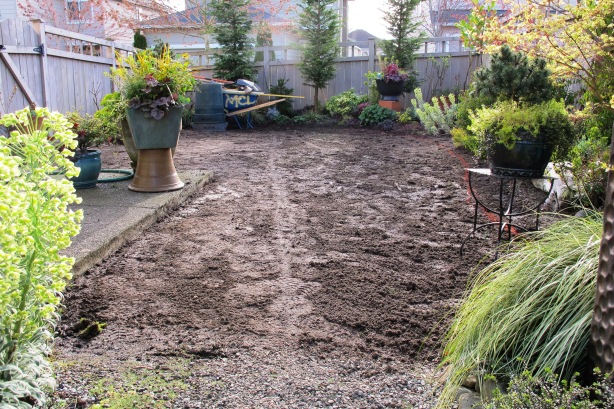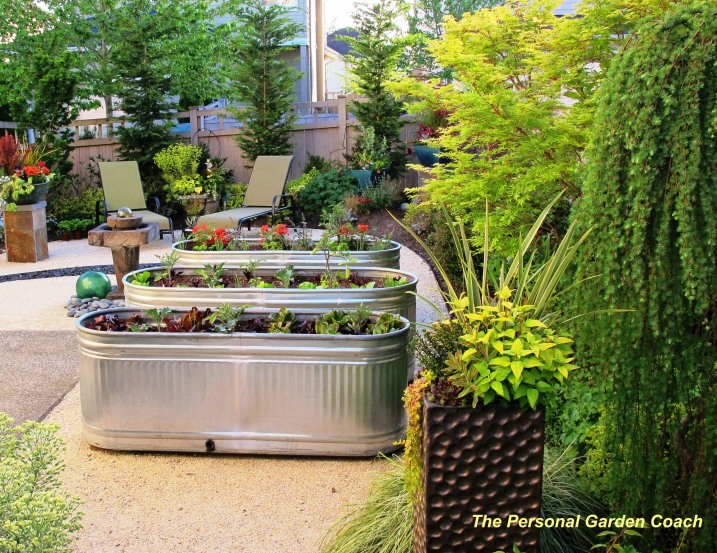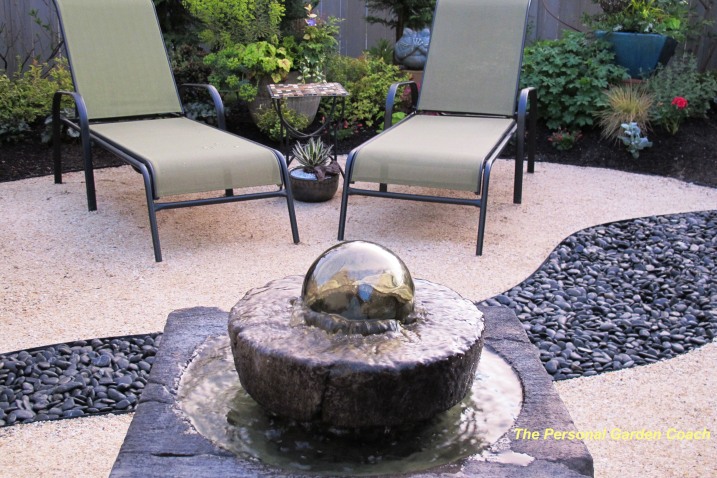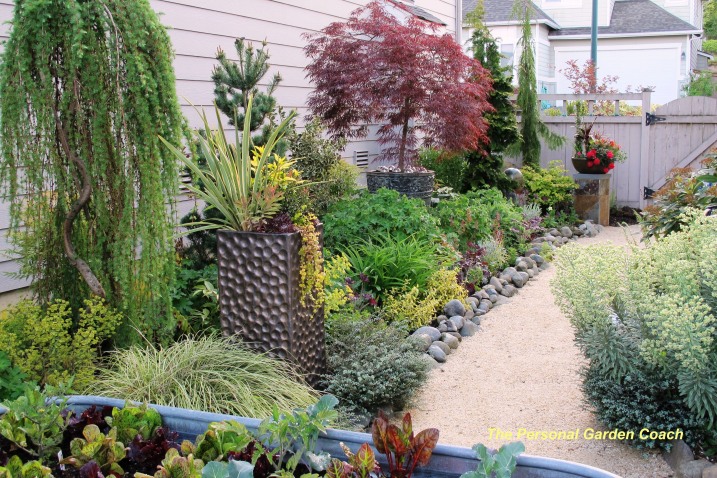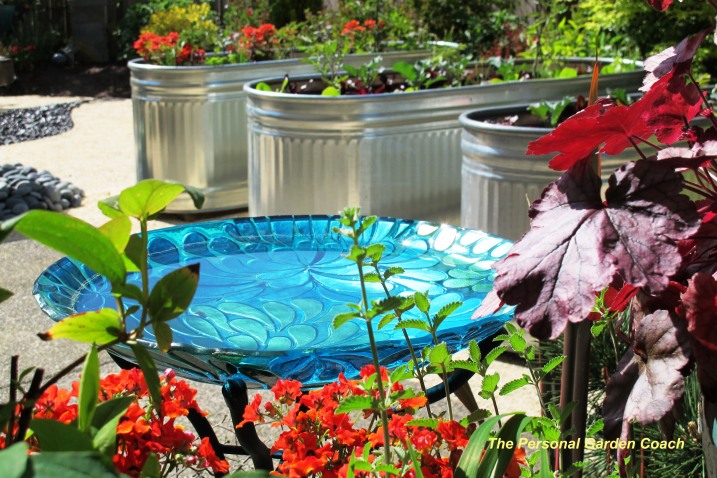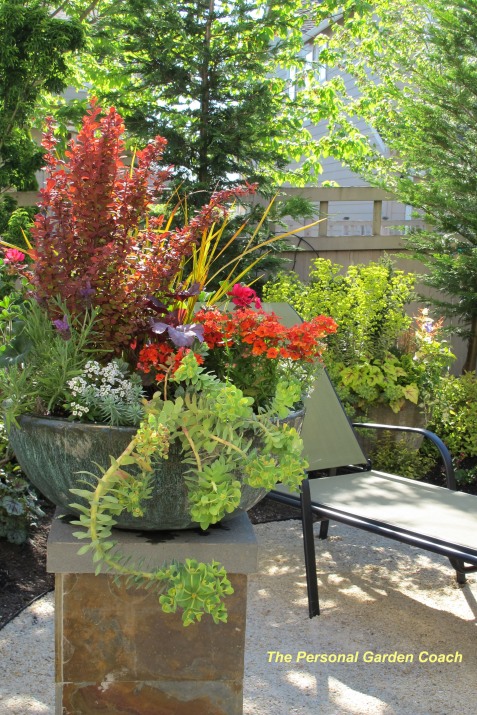Tag Archives: Shade
What Really Worked – My Favorite New Plant This Year
I suppose I should have amended that title to include “New to ME This Year” because many of you will say “What? – I’ve had that one for years!” It’s not really a new plant on the market at all. Its been around a while. But, I just haven’t warmed up to STOKESIA ‘Peachie’s Pick’ (or the Stokes Aster), until now.

I think it was the foliage pairing that did it. And me being the “Fine Foliage” girl that I am, well…ya know! The fat lavender blooms looks so great with that soft coral edge of the Acalypha wilkesiana that it just made me fall in love. What a fantastic bloomer it’s turned out to be in late summer.
Here is some information to learn more about that fabulous Stokesia.
Now for more eye candy from other wonderful garden designers on what their favorite new plant was this season. Be sure to click on their links too and learn more!
 http://www.therainforestgarden.com/
http://www.therainforestgarden.com/
 http://thedailysouth.southernliving.com/category/the-grumpy-gardener/
http://thedailysouth.southernliving.com/category/the-grumpy-gardener/
 http://www.cowlickcottagefarm.com/blog/
http://www.cowlickcottagefarm.com/blog/
 http://fromthesoil.blogspot.com/
http://fromthesoil.blogspot.com/
 http://gardeningwithconfidence.com/blog/
http://gardeningwithconfidence.com/blog/
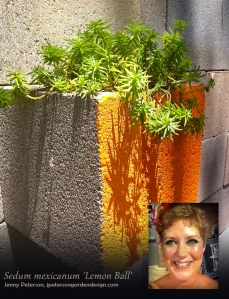 http://www.jpetersongardendesign.com/
http://www.jpetersongardendesign.com/
Like this post? We are ALL on Facebook too! Stop on by and say “Hey!”
Deep In the Green of the Moss Garden
Yesterday, I went and took a long therapeutic walk through the Bellevue Botanical Garden. The flowers were just barely starting to peek up, mostly the earliest Hellebores. But, today the truest star was the moss in all its myriad of textures and colors. Being a native here, you would think that it would be boring and tiresome to see this all the time, but I never get bored with it. Just look at the sculpture that Mother Nature left us to admire.
I tried to give you some good detail to admire, but trust me, whatever device you are looking at this on could not possibly do justice to the depth of color and texture here.

I decided there was no other word than the made up one that I thought of for this that fit it nearly as well- “Entwangled”.
Now you understand why Seattleites love their coffee SO much, if we stand still long enough in one place here this is what happens! 🙂
For more great information about all things MOSS- this is a fabulous place to visit! http://www.mossandstonegardens.com/blog/
Be sure to join me on my Facebook page: https://www.facebook.com/thepersonalgardencoach and look for my new book Fine Foliage, co- authored with Karen Chapman coming out March 1st!!
Garden Designers Roundtable – Finer Points of Details in the Garden
As the sign of the Virgo, my detail-oriented nature is ruled by the mind. Virgos are always analyzing everything, with a penchant for working with very precise and detailed designs on a more focused scale than many signs. I notice everything- when it comes to the garden. In that way, I’m the classic definition of a Virgo, the love of fine points, minutiae, particulars, specifics and technicalities.
I think that’s one reason why I love photographing the garden so much. To me it’s really all about the details. It allows another type of focus that you don’t get when you’re purely experiencing the garden with touch, smell, taste and sounds.
Today, I’ve rounded up a group of fabulous recent pictures that help you understand how I see the details at this late summer/early autumn season. ENJOY!

A singular Coreopsis ‘Big Bang Solar Cluster’ nestled in this ‘Cirrus’ Artemisia with a bit of ‘Rainbow’ Leucothoe is magical.

This container design shows it’s jaunty nature with it’s offset beret of Acorus grass planted askew and Mexican Feather Grass below that mimics the fun.
Also notice how the Poppy seed pods imitate the bumps on the container at the same level too.

Not only a monochromatic color combination, one of my favorite things, but a textural contrast too- BONUS!

This picture represents the realization that this color combination illustrates ALL of the favorite colors of my living room decor. Now THAT is detailed. 🙂
Be sure to visit the other Lords and Ladies of the Garden Designers Roundtable for September to see how they interpret the details. 🙂
Susan Cohan : Miss Rumphius’ Rules : Chatham, NJ
Lesley Hegarty & Robert Webber : Hegarty Webber Partnership : Bristol, UK
Deborah Silver : Dirt Simple : Detroit, MI
Debbie Roberts : A Garden of Possibilities : Stamford, CT
“Fine Foliage” Book Preview Debuts in Fine Form
Lush, rich, textured, bold, detailed, soft, feathery, spiky, romantic, elegant, sophisticated, dazzling, artistic, and dramatic are just a few of the many adjectives for the leaf. Or was that the needle? Or the blade? Or the branch? Foliage has a multitude of facets that I could NEVER be tired of it. I find it more technically alluring than most flowers. I think that’s the A-type in me though. It’s just the rich diversity of combinations that seems to be a design an itch I can never fully scratch.
In order to scratch that itch just a bit, I am thrilled present Fine Foliage published by our beloved St. Lynns Press.
The book that I am so proud to Co-Author with Karen Chapman of Le Jardinet is packed with the most stunning photography by our Principal Photographer, Ashley DeLatour of One thousand Words Photography. Our goal is to give you a book that you want to curl up with in winter and drool over pictures that give you ideas to day- dream over and a tool to use in spring to help you choose how to make that dream a reality.
When we first sat down and brainstormed this book, one of the very first thoughts that I had was to be able to explain “Why This Works” on every one of our 60 colorful combinations. I wanted to take the dreamy, artistic photos and make them an achievable risk for any level of gardener to take when armed with enough good information. We’ve taken extreme care to cover many areas of the country in different Hardiness Zones as well as design esthetics. As well as including annuals, perennials , shrubs and trees too in a simple and sophisticated format.
So who are these “Foliage-a-Holics” in Fine Foliage? I will quote Karen Chapman from her own blog here because I can’t write this any better 🙂 “I’m a container garden and landscape designer, serious plant-aholic, garden writer and public speaker for all things gardening. In other words I’m usually covered in a layer or two of soil, I drive everywhere with a large tarp for impromptu plant purchases and I’m truly passionate about sharing the joys of gardening.”
As for me, I would say that if you have read any of my posts you might have a fairly good idea for who I am The Personal Garden Coach, but here is the thumbnail: I’m a container designer, garden coach, garden writer, speaker and foliage-a-holic who loves to teach and see the light bulb go on when a gardener suddenly “get’s it”. I adore the entire Horticulture Industry and revel in helping others feel the same passion that I do about plants.
We have been so fortunate and honored to have the support of such respected authors “Fine Foliage is a visual treat that will inspire you with dazzling combinations for containers and gardens. This is a great user-friendly design resource as Karen Chapman and Christina Salwitz explain why each combination works, bringing artistic design within easy reach of all gardeners”. – Debra Prinzing, author of the 50-Mile Bouquet This just makes it all the sweeter.
So where can YOU buy the book you ask? 🙂 St. Lynn’s Press have listed the release date for Fine Foliage as March 1st 2013, but it will be available in time for the Northwest Flower & Garden Show, Seattle in February. At the show you’ll have the opportunity to hear Karen and I present a fun seminar based on our love of designing with foliage which will be followed by a book signing.
If you simply can’t wait until February and want to save a few $$’s then be sure to pre-order Fine Foliage through these fine booksellers.
Barnes & Noble – coming soon!
For the daily action though, follow us on Facebook and Twitter. We will endeavor to post THE most luscious and yummy photos and information that we can muster to hold you until your copy is available!
Looking to the Landscape for Mental Healing
*Please take your time with this one and pass it on to anyone you know who might be in need, thanks!
Working a job in a nursery, running my own business and writing a book, taking care of family and a geriatric dog are the tip of the iceberg for the makings of my very busy life. I’m CERTAIN that yours is as well, many of you can take that list and multiply the dimension of stress by two or three without a doubt in my mind.
I found myself in very desperate need of a mental health break, if only for an hour yesterday, when a client mentioned that she had recently been to the local botanical garden and how beautiful it is right now. The Bellevue Botanical Garden is a place that I typically only have time to visit in the “off-season”. So, when my client mentioned this, I was kind of dumbstruck by the idea that I should pit-stop by there on the way to my next client and take some time for myself.
The very idea of visiting this place for just a quick hour, to dash in and soak up the loveliness seemed SO decadent and truly illicit with everything else on my plate. But, as I pulled into the parking lot, my heart racing with anticipation of meeting my heart’s desire for a moment of afternoon delight, I realized that this really is important. And why the heck was I feeling SO dang guilty about it?
I know a good number of people whom I dearly wish I could give this same healing moment to, so this my dear friends, is my gift to you. Yes, YOU! After a life altering decision that stressed you out to the point of a migraine, this is for YOU! After a serious surgery that takes a very long and hugely painful recovery, this is for YOU! After losing a beloved and dear friend, this is for YOU! After having a difficult time with a spouse and trying to decide your life’s direction, this is for YOU! While suffering with a debilitating disease daily, this is for YOU! And to the many others who work tirelessly and silently to help heal, this is most especially for YOU!
This moment begs for a bit of revelry about the idea of “inspiration” as well. I can think of no better thing to illustrate that point than this scene with Audrey Hepburn and Richard Dreyfuss in one of my all time favorite movies “Always” where she explains Divine Inspiration. It gives me great comfort and makes me think of my own personal relationship with nature. I hope you feel it too.
I’m also inspired by a writer and philosopher named Eckhart Tolle and his book “Stillness Speaks”. Here is a wonderful excerpt from the book that might be enlightening for you as well as my photo journey that special hour. ENJOY and HEAL thyself. 🙂
Chapter 7
Excerpted from: STILLNESS SPEAKS
By Eckhart Tolle
We depend on nature not only for our physical survival. We also need nature to show us the way home, the way out of the prison of our own minds. We got lost in doing, thinking, remembering, anticipating – lost in a maze of complexity and a world of problems.
We have forgotten what rocks, plants, and animals still know. We have forgotten how to be – to be still, to be ourselves, to be where life is: Here and Now.
Whenever you bring your attention to anything natural, anything that has come into existence without human intervention, you step out of the prison of conceptualized thinking and, to some extent, participate in the state of connectedness with Being in which everything natural still exists.
To bring your attention to a stone, a tree, or an animal does not mean to think about it, but simply to perceive it, to hold it in your awareness.
Something of its essence then transmits itself to you. You can sense how still it is, and in doing so the same stillness arises within you. You sense how deeply it rests in Being – completely at one with what it is and where it is. In realizing this, you too come to a place of rest deep within yourself.
When walking or resting in nature, honor that realm by being there fully. Be still. Look. Listen. See how every animal and every plant is completely itself. Unlike humans, they have not split themselves in two. They do not live through mental images of themselves, so they do not need to be concerned with trying to protect and enhance those images. The deer is itself. The daffodil is itself.
All things in nature are not only one with themselves but also one with the totality. They haven’t removed themselves from the fabric of the whole by claiming a separate existence: “me” and the rest of the universe.
The contemplation of nature can free you of that “me,” the great troublemaker.
Bring awareness to the many subtle sounds of nature – the rustling of leaves in the wind, raindrops falling, the humming of an insect, the first birdsong at dawn. Give yourself completely to the act of listening. Beyond the sounds there is something greater: a sacredness that cannot be understood through thought.
You didn’t create your body, nor are you able to control the body’s functions. An intelligence greater than the human mind is at work. It is the same intelligence that sustains all of nature. You cannot get any closer to that intelligence than by being aware of your own inner energy field – by feeling the aliveness, the animating presence within the body.
The playfulness and joy of a dog, its unconditional love and readiness to celebrate life at any moment often contrast sharply with the inner state of the dog’s owner – depressed, anxious, burdened by problems, lost in thought, not present in the only place and only time there is: Here and Now. One wonders: living with this person, how does the dog manage to remain so sane, so joyous?
When you perceive nature only through the mind, through thinking, you cannot sense its aliveness, its beingness. You see the form only and are unaware of the life within the form – the sacred mystery. Thought reduces nature to a commodity to be used in the pursuit of profit or knowledge or some other utilitarian purpose. The ancient forest becomes timber, the bird a research project, the mountain something to be mined or conquered.
When you perceive nature, let there be spaces of no thought, no mind. When you approach nature in this way, it will respond to you and participate in the evolution of human and planetary consciousness.
Notice how present a flower is, how surrendered to life.
The plant that you have in your home – have you ever truly looked at it? Have you allowed that familiar yet mysterious being we call plant to teach you its secrets? Have you noticed how deeply peaceful it is? How it is surrounded by a field of stillness? The moment you become aware of a plant’s emanation of stillness and peace, that plant becomes your teacher.
Watch an animal, a flower, a tree, and see how it rests in Being. It is itself. It has enormous dignity, innocence, and holiness. However, for you to see that, you need to go beyond the mental habit of naming and labeling. The moment you look beyond mental labels, you feel that ineffable dimension of nature that cannot be understood by thought or perceived through the senses. It is a harmony, a sacredness that permeates not only the whole of nature but is also within you.
The air that you breathe is nature, as is the breathing process itself.
Bring your attention to your breathing and realize that you are not doing it. It is the breath of nature. If you had to remember to breathe, you would soon die, and if you tried to stop breathing, nature would prevail.
You reconnect with nature in the most intimate and powerful way by becoming aware of your breathing and learning to hold your attention there. This is a healing and deeply empowering thing to do. It brings about a shift in consciousness from the conceptual world of thought to the inner realm of unconditioned consciousness.
You need nature as your teacher to help you re-connect with Being. But not only do you need nature, it also needs you.
You are not separate from nature. We are all part of the One Life that manifests itself in countless forms throughout the universe, forms that are all completely interconnected. When you recognize the sacredness, the beauty, the incredible stillness and dignity in which a flower or a tree exists, you add something to the flower or the tree. Through your recognition, your awareness, nature too comes to know itself. It comes to know its own beauty and sacredness through you!
A great silent space holds all of nature in its embrace. It also holds you.
Only when you are still inside do you have access to the realm of stillness that rocks, plants, and animals inhabit. Only when your noisy mind subsides can you connect with nature at a deep level and go beyond the sense of separation created by excessive thinking.
Thinking is a stage in the evolution of life. Nature exists in innocent stillness that is prior to the arising of thought. The tree, the flower, the bird, the rock are unaware of their own beauty and sacredness. When human beings become still, they go beyond thought. There is an added dimension of knowing, of awareness, in the stillness that is beyond thought.
Nature can bring you to stillness. That is its gift to you. When you perceive and join with nature in the field of stillness, that field becomes permeated with your awareness. That is your gift to nature.
Through you nature becomes aware of itself. Nature has been waiting for you, as it were, for millions of years.
 Excerpted from: STILLNESS SPEAKS, by Eckhart Tolle, $17.00, Hardcover, Published by New World Library and Namaste Publishing
Excerpted from: STILLNESS SPEAKS, by Eckhart Tolle, $17.00, Hardcover, Published by New World Library and Namaste Publishing
Garden Designers Roundtable: Designers Home Landscapes
At the Garden Designer’s Roundtable this month we will show you our own gardens. This is no small thing for us, because most of us designers are busy at YOUR house making it look beautiful. And then we get home and experiment in our own gardens so you don’t have to. Truly, I don’t have a plant hoarding issue. Am I selling that well? 🙂 Actually it is true. I buy plants and trial and error them at home fairly frequently, strictly for testing purposes. Still buyin it?
OK, actually we do try out design ideas and test some plants from Growers and Breeders. We try to figure out the million dollar Bunny and Deer deterrent fixes. We use our gardens for our own blogs to show our successes and sad seasonal distresses, but it’s really just our own place to play just like yours, the good the bad and the really really bad. We just don’t usually bare our collective souls like this to the general public.
So, ready or not here is a snap shot of where my back yard landscape has begun and where it is today thanks to my friends at May Creek Landscape.
We downsized from our giant, custom-built dream home in 2007 just before the crash in 2008 to what I lovingly refer to as our “Barbie Doll House”. We bought our current home in the middle of the block in an almost brand new neighborhood about 30 seconds from our former home so that our teenager would be able to finish school and stay near friends until she went off to college.
As a former Real Estate Agent who worked for one of the 5 builders in this planned community I knew the neighborhood well and the small, contemporary San Fransisco lot styles with the alley in the back were just the right amount of maintenance for me to handle. Our side yard property line is right up to the neighbors foundation.
When we bought the home it had already had two owners, most recently 5 Bachelors with a motorcycle hobby. Yup, they were beloved by ALL the neighbors for sure. Not to mention that yard maintenance was not exactly a priority. So, it was a typical example of a NEW fixer upper these days. But, also a VERY blank canvas from the stand point of the garden.

I failed to get shots in 2007 of the gardens, I was too busy cleaning and planting! This pic shows the back yard in 2008, one year after we moved in. This gravel path and the beds on either side as well as all of the plants you see here did not exist at that time.
I’m pretty sure I spent the better part of the first year simply adding soil to even make it diggable. Yes, that is the most correct Hort-term I could think of for this awful, hard-pan clay soil. Also, as you can see across the back side, privacy is an issue, so my baby Leyland Cypress trees that I started as 1 Gallons are 3 ft. tall in this picture. I also started creating English Laurel Standards from 1 Gallon babies too- wait until you see those now!
The drainage here is abominable. The lawn is just a bog all winter and most of spring until it dries out in summer and then it’s impossible to keep watered. Even the dog didn’t want to walk out there. Luckily all of those big tree roots have been helping to suck some of it up.
Now skip ahead to early spring of this year before any of the color and fluff came on and this was where we were in 2012. My MASTER Plan is about to unfold before your very eyes!
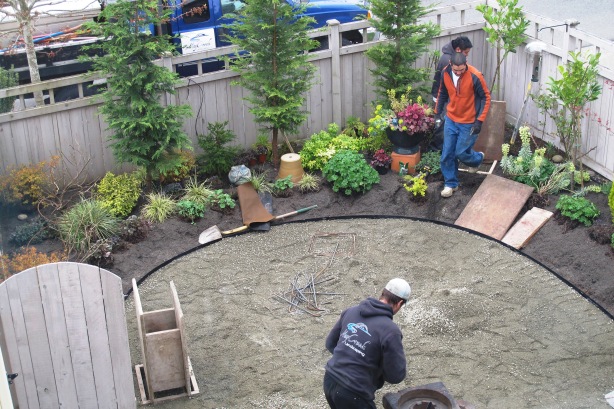
The Gravel base my patio and edging are down.The guys are getting the forms ready for the 3 concrete pedestals for my containers and building my water feature. The pedestals will be covered with slate tiles. Check out the size of my very pruned Leyland Cypress trees and Laurel Standards now!
Ta da! There are still a few tweaks and of course more plants needed. But, for the most part, it’s exactly as I had envisioned it. My landscape crew thought my idea was totally nuts, but now they see the light!
More updates on the new back yard to come this summer as I finish planting and getting it just the way I want it, this is only 2 weeks old now! I’ve now bared my garden soul to all of you. I hope you enjoyed what took me a long time to get here.
Please be sure to take a look at what the other brilliant Lords and Ladies of the Round Table have to share as well!
Susan Morrison : Blue Planet Garden Blog : East Bay, CA
Rebecca Sweet : Gossip In The Garden : Los Altos, CA
Pam Penick : Digging : Austin, TX
Mary Gallagher Gray : Black Walnut Dispatch : Washington, D.C.
Jocelyn Chilvers : The Art Garden : Denver, CO
Deborah Silver : Dirt Simple : Detroit, MI
Debbie Roberts : A Garden of Possibilities : Stamford, CT
Christina Salwitz : Personal Garden Coach : Renton, WA
Devotedly Hoarding and Dividing Spring Perennials
It has turned out that I have a great passion for collecting Heuchera, Heucherella and now some Tiarella too. Especially in part due to the eye candy of plants at the Terra Nova website. Dan Heims of Terra Nova Nurseries has built an empire of Heuchera and MANY other tempting delights. I never thought of myself as one of those gardener’s who would have a fixation for assembling great numbers of any one genre of plant, but these seem to be my thing. All right, you got me. That’s not ENTIRELY true I must have Euphorbia too!
I did have quite a love affair with Nandina of ALL types for many years, they still have a place in my heart, just not as ardently. I had an extremely prized ‘Threadleaf’ Nandina that made it to an impressive size at one home. I couldn’t bear to dig it up and take it with me as it seemed to complete the spot near the front door where it thrived.
You could add on to my list of devotions, Hellebore’s and Conifer’s now, thanks to my friend Mitch, a serious collector. His influence on me has been profound in a Plant Porn kind of way. I go to his garden for a biennial fix. Mitch is going to give me a division of some of his gorgeous Blue ‘Willow’ Gentians. I am SO excited!
It occurred to me the other day as I was out on spring garden clean up day two of probably ten, that I had not divided the Heuchera’s since I had been at this house. So, I grabbed my camera to show you, if you have never done it. It’s a shame that many people simply let them die and don’t realize that Heuchera can be divided incredibly easily and with a fabulous ratio of success!
When your, let’s call her the “Mama” Heuchera gets to about 4 years old or so, you will begin to see the foliage diminish slightly and she will develop finger length “Pups” that stick up about 3-4″ with a little tuffet of leaves at the top. I know this is terribly technical, but, stick with me! 🙂
In late March, I will either, dig up the whole plant, or if she’s a tough broad, sometimes I will just rip chunks off of her right from the ground. You will usually see anywhere from 5-10 “Pups”. Some that will be large and fat, about 4″ long and an inch around and some that are really small, only a few inches long and 1/3″ around. Yesterday, I got more than 40 divisions out of 5 plants. That’s a pretty great ROI on plants that are not inexpensive!
Simply plant them back in the garden, roots side down. 🙂 Then hurry up and wait! Smaller ones take longer, larger ones just take off. Easy peasy! Try it and save yourself a few bucks to go out and get obsessed about a new plant to spend your money on.

Hmmmmmm…. Terra Nova has these new Kniphofia I have been eying.
Wordless Wednesday 1/18/12 – Lichen It
Garden Designer’s Roundtable – Deer vs. Gardener
It’s common for many gardener’s to be plagued by the dreaded problem of the garden becoming a Deer Buffet. Imagine a blinking red neon sign over your gate that reads, “EAT here” that remains on until the plants are nubbins, or just tipped enough that they never bloom.
Sometimes you feel like you put out the WELCOME sign for Bambi. 🙂
There are oodles of resources on the web for researching Deer “RESISTANT” plants on the web. Here’s one of the very best that I’ve seen. The Sunset western Garden Book has a Deer-Resistant list is a pretty darn good compilation too. So, I’m not going to go into it in any depth on the plant list end of things. Particularly since you need to check with your local nursery expert to see which are appropriate for your area anyway.
Notice I use the term “RESISTANT’ and not “DEER-PROOF”. There is a huge leap of Horticultural faith that needs to take place here when you learn the difference.
The strategy that I use and teach my clients for keeping deer at bay in the garden is this:
1) Deer are hungry.
2) Adult Deer have defined palates.
3) Young Deer eat whatever Mom eats.
4) It’s the Teenagers that do all the damage and eat EVERYTHING at least once.
This explains why there is no such thing as any Deer PROOF plant. Plant choices can vary from Region to Region and Zone by Zone. The best we can do is be thoughtful about the strategies we use about planting in areas where Deer have access to our gardens.
Here is the full extent of my strategy:
1) Plant pokey and annoying plants.
2) Anything that will make it difficult or annoying to reach the food they want is fair game.
3) Think ankle biting plants like Barberry or Juniper that they might have to step through to get to the good stuff.
4) For annoying plants, think about anything that smells great to us, like Rosemary or Lavender. Deer have such a highly attuned sense of smell that to them, these lovely things smell horrifying.
5) In general, just make it too much work to get to your tender and tasty buffet.
Here’s a shot of my front yard this Fall. Not bad huh? No Deer damage this year at all!
The above picture shows my Red Barberry ‘Crimson Pygmy’ alternated with Spanish Lavender, Eunoymous Fortunei ‘Emerald-n-Gold’ and Nandina ‘Gulf Stream’. Plus ‘Tri-Color’ Sage for an extra dose of smelliness with Hebe ‘Quicksilver’ and a beautiful Heather that’s turned bright red for Fall and Winter. I can’t remember which one it is though, I’ve been collecting red Heathers and have not been good at record keeping.
Here’s is one of the best plants for shade and Deer-Resistance from Great Plant Picks, Brunnera ‘Jack Frost’, one of my favorites!

Photo Credit - Chris Hansen, http://www.GreatPlantPicks.org
Go forth and plant in your Deer grazing area, just do it thoughtfully. Deer munching WILL happen. Go with the flow, change plants out if need be. But mostly, don’t let the Bambi’s get you down!
Please visit the blogs of other Lords and Ladies of The Garden Designer’s Roundtable and read what valuable advice they have on Deer too!
Lesley Hegarty & Robert Webber : Hegarty Webber Partnership : Bristol, UK
Genevieve Schmidt : North Coast Gardening : Arcata, CA
Pam Penick : Digging : Austin, TX
Douglas Owens-Pike : Energyscapes : Minneapolis, MN
Christina Salwitz : Personal Garden Coach : Renton, WA






